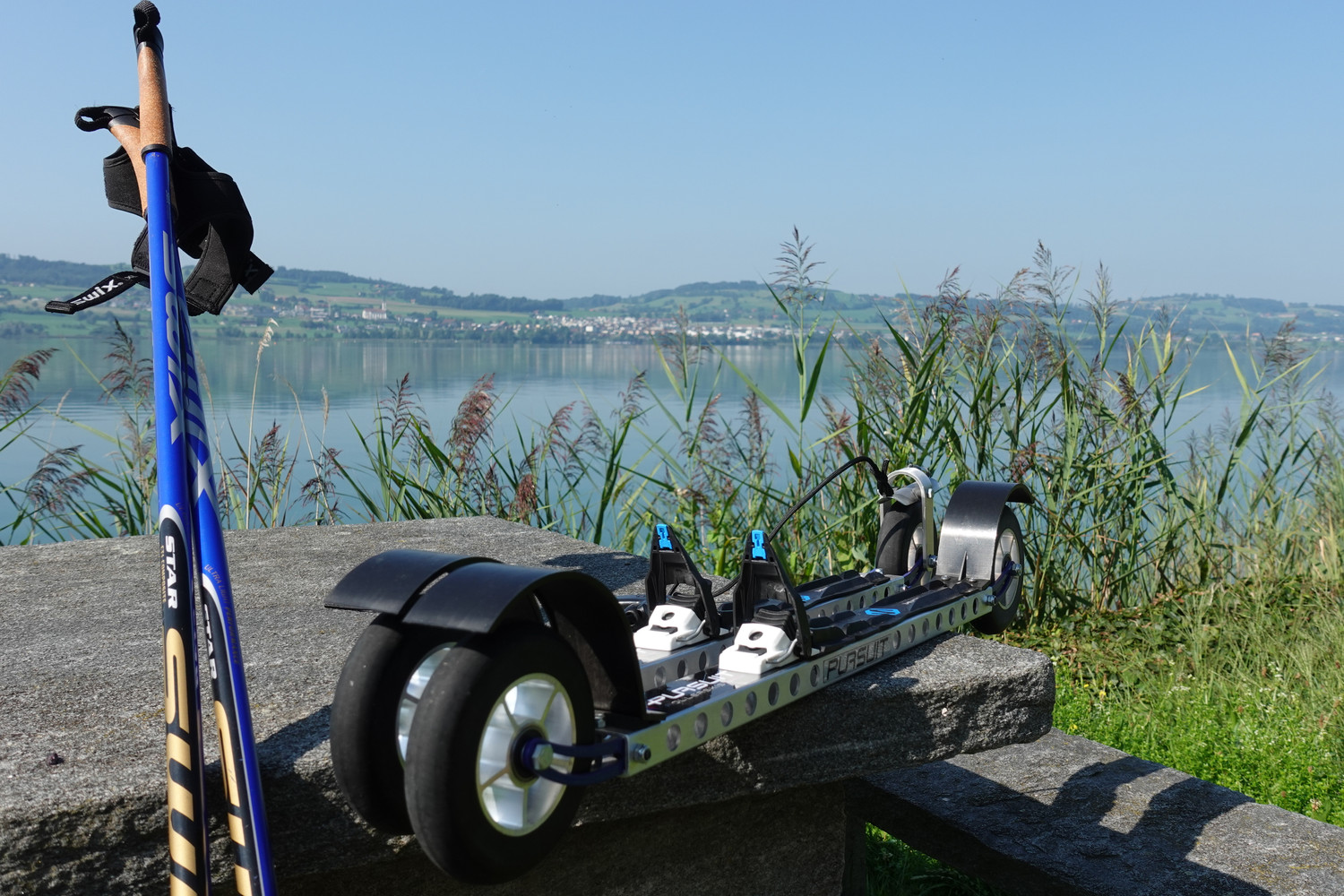Things to consider when selecting a skate rollerski
Frames:
- Material: Alloy, composite, combination of materials.
- Stiffness: Super soft flex, medium flex, or rigid. If flex, is it concave or flat flex?
- Stability: The lower the top of frame height to ground unweighted and weighted, as well as relationship of top of frame to center of axle bolt will determine stability. This is usually achieved through fork drop.
- Durability: Sometimes you will end of bottoming out due to heaved pavement or skating off the edge of the paved trail. Some frames are more durable for this.
- Ground clearance: Lower frame means more stability, but depending on frame thickness, it can start impacting ground clearance. Generally 30 mm of clearance is sufficient if durable frames.
- Frame and axle bolt width: Wider bolts sticking out the side of frames mean more scraping if they are long enough. When the rski is angled a good amount, longer bolts will start to scrap, so a more narrow frame means less/no scraping, and this is affected also by frame height. Some models have super long axle bolts, and they will scrap also (such as a 55/60 mm axle bolt on a 100 mm wheel).
- Wheelbase: Generally longer will feel more like a snow ski assuming lightweight. Longer frames can fatigue quicker however, and some frame materials fatigue quicker than others after thousands of cycles of flexing. Longer wheelbases can be more tiring as they are more of a leg workout. Too short of a wheelbase will be tail heavy, and more carvy feeling. Longer wheelbase will have less tail drop and glide with less carve ability. Generally young kids with small feet should be on shorter wheelbase, and those with big feet and/or elite on longer.
- Weight limit: Most brands don’t advertise but some do. Many variables can affect the weight limit. It really comes down to fatigue properties of the design when taking heavy impacts. Biggest impacts are heavy weight skier hitting a big crack, creating a big impact force. Agility courses can be very hard on most rskis also, and generally not recommend by most brands.
- Tracking: Most rskis have axle holes just big enough for axle bolt. Some however have what is called adjustable tracking where the axle hole is bigger. Risk there is the tight axle could shift in the hole upon big impact. May sound strange, but generally most tracking can be adjusted some by hitting the side of the wheel on the pavement to bend the forks/frame slightly to adjust the wheel alignment. Some brands use an alignment verification jig after mounting wheels to verify true alignment.
Wheels:
- Diameter and width: Most solid skate wheels are 100 mmx24mm, but 105, 110 solid wheels are on the market. Most pneumatic wheels are larger 125-150 mm. Can’t get a flat with solid wheels, but pneumatic you can go on crushed gravel trails. Pneumatic rskis weigh a lot. Most solid skate wheels are ~24 mm wide, so you can transition the angle smoothly through the skate phases. Wider wheels with a flatter profile can change this angle transitioning to be not as easy.
- Speed: Most brands offer different speeds. Different speeds usually come from using different material, and some speeds last longer than others. A fast wheel is going to have higher rebound than a slower wheel (Imagine dropping a wheel, a fast wheel with higher rebound would bounce higher, transferring the energy vs absorbing it).
- Wear longevity: How many miles can you expect to get out of the wheels, and what is the replacement cost and availability of the wheels?
- Bearings: Shielded vs sealed. Most are sealed. Within the sealed category there is still a wide range of quality. 608 size sealed bearings vary a lot across brands.
- Traction: Some wheels get better traction than others, not just in wet conditions but on dry pavement also.
Weight:
- Overall weight should be light. Most rollerskis are heavier than snow skis.
- Weight distribution: Want weight not in the frame but rather the ends, to create a higher swing weight quotient (swing weight ÷ total weight) to feel like a longer snow ski.
Fenders:
- Great and pretty much a necessity if going on wet pavement. Rigid fenders might be more prone to breaking if you crash. Super soft fenders won’t break as easily but can get deformed if bent in storage.
Binding Mounting:
- You want the bindings to be mounted as far back on skate rollerskis as possible to get the toe bar as close to the balance point as possible assuming not super long in which case you could mount on the balance point. This is because most skate rskis are too short to mount on the balance point, so want to get close to it. Need to make sure back of boot clears back fender/wheel, but don’t want much extra space back there. This means for a lot of people the heel plate should be trimmed shorter to get the binding mounted further back.
Brake:
- Without a brake there are some methods to slow down, and some people are quite good at them, but usually increase wheel wear snowplowing. Some brakes require binding to be mounted further forward to mount the brake. This will create extra tail drop.

